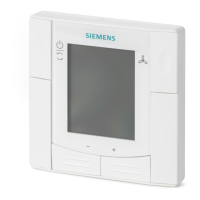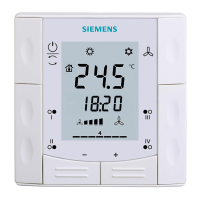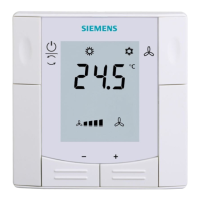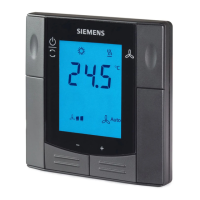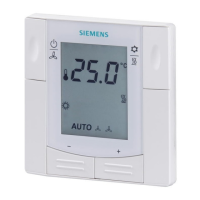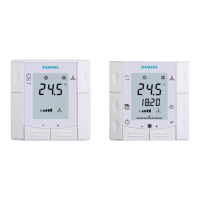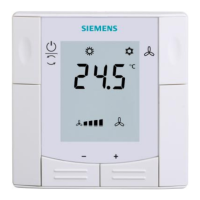56 / 94
Siemens RDF800KN.., RDF800KN/VB, RDD810KN/NF Basic documentation CE1P3174en
Smart Infrastructure 2020-02-21
3.11.4 Example of heating and cooling demand zone
The building is equipped with Synco controls on the generation side and with
RDF../RDU../RDG.. room thermostats on the room side.
RMH760 RMH760 RMB795
Konnex TP1
RDG..RDU..
RDF..
T
T
T
T
T
T
1
2
Heat requistion
Heat demand
Heat distr zone 1
Heat source
Controller 1 Controller 2
Controller 3
Controller 4 Controller 5 Controller 6
Controller 1 Controller 2 Controller 3 Controller 4 Controller 5 Controller 6
Heating circuit
fan coil
Fan coil
room A
VAV box
room B
Fan coil
room C
DHW heating
Heat demand
Heat demand
Heat demand
Heat demand
Heat requistion
Heat distr zone
source side: 1
Heat distr zone 2
Heat distr zone 2 Heat distr zone 2
Heat distr zone 2
Setting values
MV M
V
T
T T
In typical applications, the individual RDF../RDU../RDG.. room thermostats send
their heat demand directly to the primary controller (in the above example to the
RMH760).
and designate the numbers of the distribution zone.
· This type of application can analogously be applied to refrigeration distribution
zones.
· If no 2-pipe fan coil unit is used, heat and refrigeration demand signals are sent
simultaneously to the primary plant.
3.11.5 Send heartbeat and receive timeout
In a KNX network, S-mode and LTE mode communication objects can be exchanged
between individual devices. The Receive timeout defines the period of time within
which all the communication objects requested from a device is received at least
once. If a communication object is not received within this period, a predefined value
is used.
Similarly, the Send heartbeat defines the period of time within which all the commu-
nication objects requested must be transmitted at least once.
Fixed times are specified as follows:
· Receive timeout: 31 minutes
· Send heartbeat: 15 minutes
Explanation relating to
LTE mode/S-mode
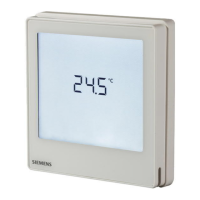
